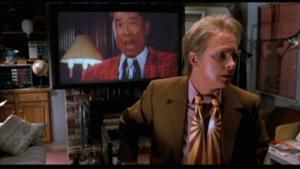Good Monday to you, dear readers! Last week, your humble blogger watched in utter horror as his body valiantly but ineffectively fought off the flu. As rumor has it, as certain strain of Influenza A is not covered by this year’s flu shot, which is of particularly little comfort as your humble blogger didn’t manage to get the flu shot this year. As I recall, the though was something along the lines of “what are the odds that I would get the flu?”
Well, no doubt, odds had nothing to do with it, and in some applicant attorney’s or lien claimant’s office is a little voo-doo doll shaped and dressed like a striking and handsome defense attorney, with a flu needle embedded deep into the poor doll’s lungs. Certainly, as Friday rolled around and my humblest of blogs was missing another of those charming blog posts, the villain laughed and laughed. I hope, sir, that your soul was worth it!
In any case, for better or worse, your humble blogger is back now – but this terrible experience got me thinking – is the flu compensable? Can a worker claim an industrial injury in the form of the flu? Some flu symptoms last a long time, and some cause complications… so does your humble blogger have a claim?
After all, our law provides insidious disease and cumulative trauma – so if the office is full of hard-working people not concerned with infecting their co-workers, could the constant exposure to all the coughing, sneezing, and touching be considered an occupational disease?
For starters, let’s turn the clock back to when construction of the Golden Gate Bridge was first started: back in 1933, the Industrial Accident Commission (the predecessor to the WCAB which still nags the WCAB about not calling enough). In Marsh v. IAC, the commission ruled that “[a]n ailment does not become an occupational disease simply because it is contracted on the employer’s premises. It must be one which is commonly regarded as natural to, inherent in, and incident and concomitant to the work in question.”
Fair enough… but if the employer’s policy is such that it openly or tacitly encourages employees, or even requires them, to come to work when they’re sick, aren’t the other employees getting sick specifically because of the work conditions in that office/work-site?
The holding in the 1943 California Supreme Court Case of Bethlehem Steel Company v. Industrial Accident Commission was that “when an employee contracts a contagious or infectious disorder he must, in order to recover compensation, establish the fact that he was subjected to some special exposure in excess of that of the commonality, and in the absence of such showing, the illness cannot be said to have been proximately caused from an injury arising out of his employment.” (Emphasis in original).
But what about influenza? The applicant(s) in Bethlehem had contracted a contagious eye disease known as kerato conjunctivitis, the exposure for which was sustained in a shipyard. Anyone can get the flu.
In the matter of Vilarino v. Chromatics (several panel cases, mostly having to do with defendant’s right to credit in applicant’s third-party suit against the flu-shot company), the trial judge held, back in 1999, that applicant’s injury, sustained as the result of a reaction to the flu vaccine administered by a company contracted by the employer to provide voluntary flu shots, was compensable. But can’t just about anyone get a flu shot?
In Watrous v. PUSD, applicant, a teacher, contracted Parvovirus, which the WCAB ruled was more likely than not the result of her exposure to hundreds of children. Doesn’t everyone have occasion to interact with those biological weapons known as kids?
Kane, Canelo and Temple v. WCAB (Baker), a 1976 decision by the Court of Appeal, held a legal secretary’s death from pneumonia secondary to influenza was compensable. In that case applicant’s widower established that she was more susceptible to colds than other employees because of myasthenia gravis, an autoimmune or congenital neuromuscular disease, and the cold lead her to contract influenza, which ultimately caused her death. The COA also noted that for a very long time, the secretaries in that office had complained about the extreme variations of temperature due to ongoing problems with the air conditioning. So, at least according to this Baker, the fact that anyone can catch a cold, and anyone can catch the flu, does not bar compensability.
By contrast, recall, if you will, the case of Reff v. WCAB (writ denied), where the WCAB had rejected applicant’s claim that her industrially contracted pneumonia aggravated her pre-existing common variable immune deficiency, resulting in very serious and debilitating symptoms. The WCAB held that applicant’s worsening would have eventually happened when any number of things triggered her CVID, which, if applied to the Baker or Vilarino may have resulted in a different finding, given that pre-existing conditions triggered by coincidentally work-related circumstances.
So, from the looks of the relevant case law, something like the flu can be compensable, hypothetically, but you’re probably going to need more harm done than your humble blogger’s ruined week, and to demonstrate something specific to the workplace which increased the applicant’s exposure to the flu, or any other disease (and my theory about the voo-doo doll probably doesn’t hold water…) Just another example of how the system neglects the suffering of hard-working defense attorneys…

